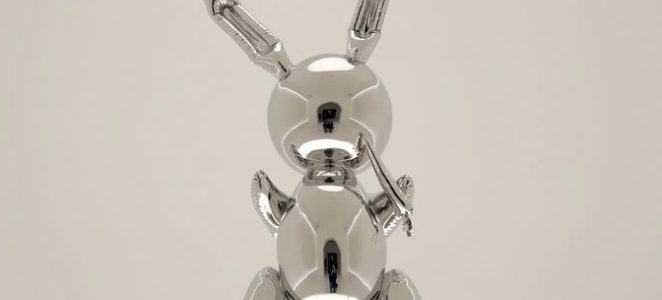Modern art is back in the news. A sculpture by Jeff Koons was purchased at auction for a record $91 million at Christie’s this week. The buyer was Steve Cohen, a hedge fund something or other, and the purchase was made by art dealer Bob Mnuchin, father of the secretary of the Treasury.
So, about this three-foot, 91 million inflatable stainless steel bunny: is it great art? Or is this late-stage capitalism high on cocaine?
Why not both? Koons is not on my top anything list of artists. I find him a little kitschy and droll, but I get it. Starting in the early part of the 20th century, not surprisingly as photography became more commonplace, the role of the artist, painter, sculptor, or whatever changed dramatically.
These artists were no longer tasked with depicting the world as it is. That was taken care of. A handful of annoying hyper-modernist West Coast painters in the 1990s did super-accurate paintings of sock drawers and refrigerators for a while, but they sucked and thankfully that trend is over. Instead, today’s artist is almost inevitably a disciple of Marcel Duchamp, by far the most important art creator of the 20th century.
Even at the time of Duchamp’s death in 1968, it was not clear that he had transformed the art landscape as dramatically as he ultimately did. At the time, more traditional artists like Pablo Picasso and Piet Mondrian were considered far more important.
After his death, much of his art wound up in the collection of the Philadelphia Museum of Art. Although that collection contains some lovely representational pictures like “Nude Descending a Staircase (No. 2),” the more famous and notable pieces are his ready mades. A urinal he called “Fountain,” which became a work of art simply by him signing it and putting it in a gallery, is one of the seminal works.
What truly solidified Duchamp’s place as the champion of 20th-century art was his influence on another 20th-century master, Andy Warhol. Warhol took Duchamp’s idea that everyday objects or products were works of art to a new level by fabricating them. Famously in his Brillo Boxes, and his Campbell’s soup canvasses, he explored the extraordinary nature of the ordinary.
One thing that both Duchamp and Warhol understood was that, in the modern world, certain objects and products became universal. The wealthy and the poor both drank Coca Cola and smoked Marlboros, Decades after their deaths, we all tap out our lives on smartphones, and use the same apps. Whereas once God and religion were the universal themes of Western art, Duchamp and Warhol saw that products had overtaken that role. There is no contemporary artist who better continues that tradition than Koons.
One way Koons captured the idea of the contemporary product was in his treatment of pornography. In the early 1990s, he executed a “Made In Heaven” series that is basically just giant pornographic images. Just as Duchamp had done for the urinal, and Warhol had done for the Brillo Box, Koons didn’t really jazz up the porn — aside from the size, it’s pretty run of the mill. But in retrospect, now that the Internet has essentially become a huge porn machine, it is obvious that Koons saw something early that was real and important about postmodernity and where our society was going.
So what about this stainless steel inflatable bunny? Why? What is the connection to Duchamp and Warhol’s work and, more importantly, what is the advancement? The three-foot rabbit with ears askew is new because, rather than relying on our familiarity with everyday objects like urinals and soup cans, Koons is creating a new icon. The $91 million bunny is the tech startup of art.
Where those before him saw the power of capitalism to create firm and lasting brands, Koons sees a new capitalism in which brands pop up and disappear everyday. Now the flavor of the month successfully competes with the flavor of the century.
Works like Koons’s are easy to mock. It’s a game, it’s a trick, yes, but it’s not new. Twentieth- and 21st-century art is more about the wry smile than wide-eyed adoration of beauty. It’s about being in on the joke. Getting it.
Koons gets it. In 500 years, will this little rabbit be looked at with the same devotion as the “Pieta” or the “Mona Lisa”? We won’t be there, but don’t be surprised if it is. The first and most fundamental thing an artist must do is know his own time. And Koons knows exactly what time it is.









